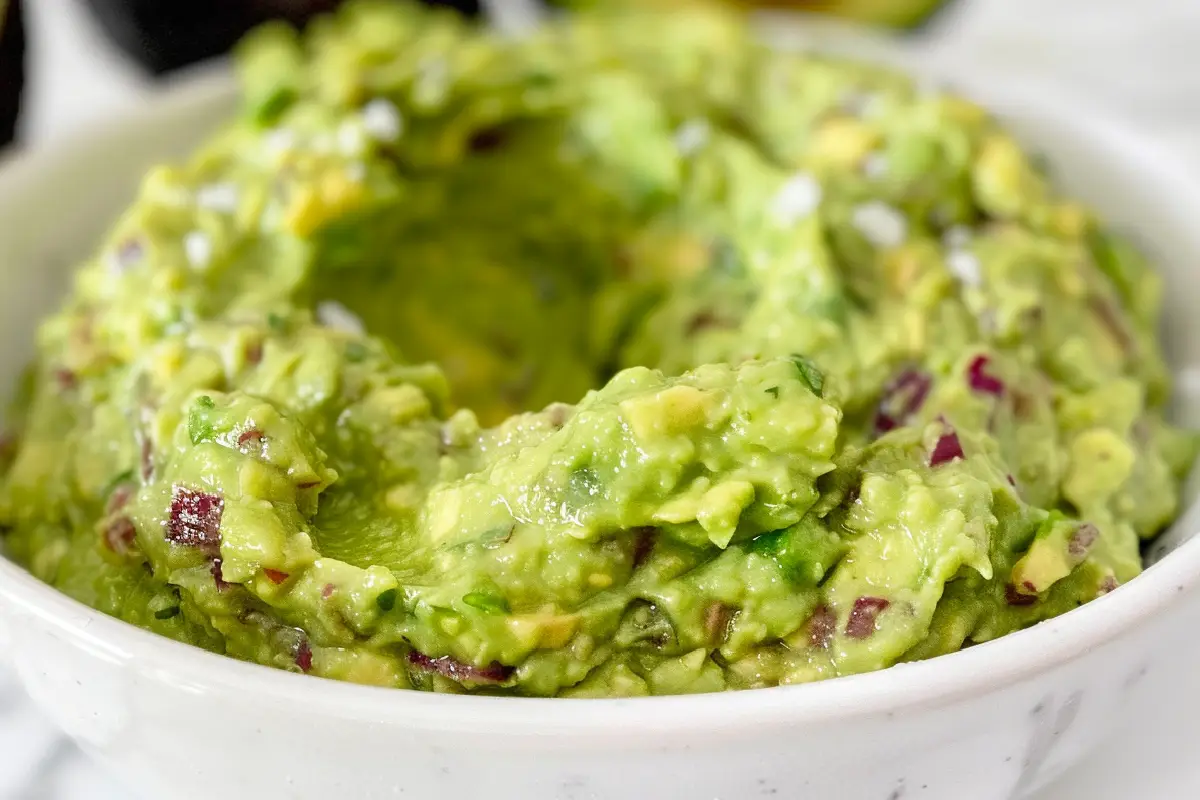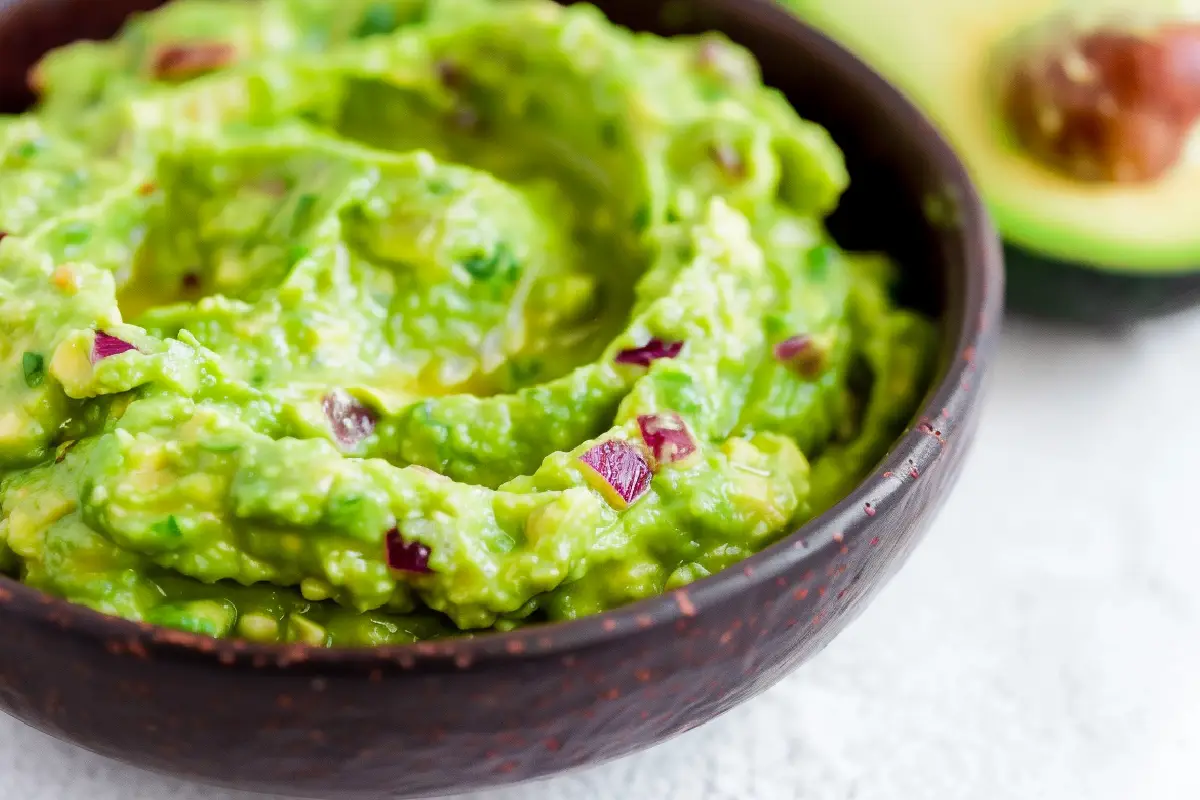Introduction
Guacamole is a classic dip that has become a staple for parties, casual get-togethers, and even a quiet snack at home. Its creamy texture and rich flavor make it a crowd-pleaser for almost any occasion, whether served with tortilla chips, as a topping for tacos, or alongside a variety of fresh vegetables. Yet, despite its seemingly simple nature, making perfect guacamole can be deceptively tricky. Achieving the right balance of flavors and textures requires attention to detail and an understanding of what can go wrong. Without the proper techniques, even the smallest mistakes can turn this beloved dip into a bland, runny, or unappetizing mess.
In this guide, we’ll dive deep into the most common mistakes people make when preparing sauce and how you can avoid them. From choosing the wrong avocados to using too many watery ingredients, these pitfalls can easily sabotage your dip. But don’t worry! With these insights and practical tips, you’ll be equipped to create guacamole that stands out as the highlight of any event. Whether you’re a first-time guacamole maker or a seasoned pro looking to refine your skills, this comprehensive guide will help you master the art of making the perfect guacamole that everyone will rave about.
Choosing the Wrong Avocados
The type of avocado you choose will make or break your guacamole. The ideal avocado should be ripe, but not too soft or overripe. Underripe avocados result in hard and bitter chunks, while overripe ones turn the guacamole into a mushy mess.
How to Pick the Perfect Avocado:
- Visual Inspection: Look for dark green, almost black skin. If the skin has too many dark spots or feels too soft, it might be overripe.
- Touch Test: Gently squeeze the avocado. A ripe avocado should have a slight give when pressed but should not feel mushy.
- Remove the Stem: If you can easily flick the stem off and see green underneath, it’s a good sign. If it’s brown, the avocado is overripe.
For more in-depth tips on picking the right avocados, read our article on choosing the best avocados for guacamole.
Adding Too Many Watery Ingredients
It’s tempting to add lots of extras like tomatoes or an extra squeeze of lime juice to your guacamole, but these can easily turn it into a watery dip. Here’s why that happens and how to prevent it:
Avoiding a Watery Guacamole:
- Limit Tomato Usage: Tomatoes add color and texture, but they also release a lot of water. Consider using firm Roma tomatoes or draining the excess liquid before adding them.
- Use Lime Juice Sparingly: Lime juice is essential to balance flavors and prevent browning, but too much can make the guacamole runny. Start with a tablespoon per avocado and adjust as needed.
If you’ve made your guacamole too watery, don’t worry! You can try adding a bit more mashed avocado to thicken it up, or serve it immediately to prevent the ingredients from releasing too much moisture. For more ideas on fixing guacamole texture issues, read our 4-ingredient guacamole recipe guide.
Using a Blender Instead of Mashing by Hand

Many people think that using a blender or food processor will make the process easier, but these tools can destroy the natural texture of guacamole. The result is often a dip that’s too smooth and lacks the chunky feel that makes guacamole so delicious.
Why You Should Mash by Hand:
- Texture Control: Mashing by hand with a fork or masher gives you better control over the consistency, allowing you to create a mix that’s both chunky and creamy.
- Prevents Over-Mixing: Over-mixing releases too much moisture, especially if other ingredients like onions or tomatoes are already in the mix.
For dishes that require a similar balance between chunky and creamy, check out this recipe for easy Tteokbokki, which also relies on achieving the right texture.
Not Seasoning Enough
The beauty of guacamole lies in its simple ingredients, but simplicity doesn’t mean skipping seasoning. Without the right amount of salt, pepper, and other spices, your guacamole will taste bland.
Essential Seasonings for Guacamole:
- Salt: Brings out the natural flavors of the avocado.
- Pepper: Adds a subtle heat that complements the creaminess.
- Cumin: A hint of cumin gives a smoky flavor that works well with the other ingredients.
- Chili Powder: For a little kick, add a dash of chili powder.
Experiment with these flavor enhancers until you find the perfect balance. If you love experimenting with spices, try these cheesy mashed potatoes that rely on a similar approach to seasoning.
Making Guacamole Too Far in Advance
Guacamole is notorious for turning brown due to oxidation. Making it too far ahead of time is one of the most common mistakes. Here’s how to keep it vibrant green until serving:
Tips for Preventing Browning:
- Add Citrus: Citrus juice not only adds flavor but also slows down oxidation. Add a good squeeze of lime or lemon juice to keep your guacamole green.
- Cover Tightly: Press plastic wrap directly onto the surface of the guacamole to reduce air exposure.
- Add an Avocado Pit: Leaving one of the pits in the guacamole can help prevent browning by reducing the surface area exposed to air.
Common Myths About Guacamole
There are a few persistent myths about guacamole that can lead to subpar results. Let’s debunk some of the most common ones:
Myth 1: Adding the Pit Keeps Guacamole Fresh
While the avocado pit may reduce browning directly under it, it doesn’t prevent oxidation for the rest of the guacamole. Instead, it’s best to use a combination of plastic wrap and lime juice.
Myth 2: You Can Use Any Avocado Variety
Not all avocados are created equal. Hass avocados are the preferred variety for guacamole because of their rich texture and buttery flavor. Other varieties can produce a less creamy consistency.
Myth 3: Guacamole Should Always Be Smooth
Traditional guacamole has a chunky texture. If it’s too smooth, you’ve likely over-mixed it, losing the authentic mouthfeel.
Tips for Serving
Even the best guacamole can be ruined if not served correctly. Here are some tips to make sure your guacamole is the highlight of any spread:
- Pair with the Right Chips: Use thick tortilla chips that won’t break under the weight of a chunky dip.
- Serve Fresh Veggies: Bell peppers, carrots, and cucumbers add crunch and are healthier alternatives to chips.
- Try as a Sandwich Spread: Use guacamole as a spread for sandwiches or burgers for an extra burst of flavor.
For a unique twist on dips, try pairing your guacamole with these egg bites for a delicious snack combo.
Making It Too Spicy
Adding too much heat can overwhelm the delicate flavors of avocado. Start by adding small amounts of jalapeños or serrano peppers and taste as you go.
How to Tone Down Spicy Guacamole:
- Add More Avocado: This helps dilute the heat without changing the flavor.
- Add Dairy: A spoonful of sour cream or yogurt can neutralize the heat.
- Include Sweet Ingredients: Try adding mango or pineapple for a sweet contrast to the spiciness.
Serving with the Wrong Chips
Even if you’ve perfected your guacamole, serving it with the wrong chips or sides can ruin the experience. Opt for sturdy chips that won’t crumble under the weight of chunky guacamole.
Best Sides for Guacamole:
- Thick Tortilla Chips: Perfect for scooping.
- Sliced Veggies: Bell peppers, cucumbers, or carrots for a fresh twist.
- Tacos or Burritos: Use guacamole as a topping for a burst of creamy flavor.
FAQs
Q: Why Does My Guacamole Turn Brown So Quickly?
Guacamole turns brown due to oxidation, a natural reaction that occurs when the avocado is exposed to air. To slow down the process, add lime juice and cover it tightly with plastic wrap, making sure the wrap touches the surface of the guacamole to minimize air exposure. You can also store it in an airtight container with a layer of water or olive oil on top, then drain before serving.
Q: Can I Freeze It?
Yes, you can freeze guacamole, but be prepared for some changes in texture. For the best results, avoid adding tomatoes or other watery ingredients before freezing, as they tend to become mushy. Use a freezer-safe bag or container, and press out as much air as possible. Thaw it in the refrigerator and give it a good stir before serving.
Q: How Do I Fix Guacamole That Is Too Salty?
If your guacamole ends up too salty, try adding more mashed avocado to balance it out. You can also add a dash of citrus juice (lime or lemon), finely chopped tomatoes, or even a spoonful of plain Greek yogurt to dilute the saltiness without compromising the flavor.
Q: How Long Can I Store Guacamole in the Refrigerator?
It is best consumed within 24 hours for optimal flavor and color. To keep it fresh longer, store it in an airtight container, cover the surface with a layer of plastic wrap, and add a squeeze of lime or lemon juice before sealing. It can last up to two days in the fridge, but the taste and color may start to degrade.
Q: What Should I Do If My Guacamole Is Too Spicy?
If your sauce is too spicy, add more mashed avocado to reduce the heat. Alternatively, you can mix in a bit of sour cream or Greek yogurt to mellow out the spiciness. Adding diced tomatoes, corn, or a bit of sugar can also help balance the heat without altering the core flavors of your sauce.
Conclusion

Creating perfect guacamole involves more than just throwing a few ingredients together. Every step, from selecting the right avocados to balancing flavors and serving it fresh, plays a crucial role in ensuring a dip that is both delicious and visually appealing. By avoiding these common mistakes, you can master the art of making the sauce that stands out in flavor, texture, and presentation. Remember that overripe or underripe avocados, excessive use of watery ingredients, or improper storage methods can quickly sabotage your efforts. Each mistake may seem minor, but the cumulative effect can result in a dip that falls flat and fails to impress.
However, with a few simple adjustments and attention to detail, you can transform your sauce into the perfect dish that will be the star of any gathering. Whether you’re making it for a crowd or just for yourself, following these best practices will help you achieve a creamy, chunky, and flavorful guacamole every time. Don’t be afraid to experiment with different seasoning blends or serving styles, and most importantly, enjoy the process. Guacamole is as much about the experience of making it as it is about eating it. With the right techniques, your sauce can become a signature dish that family and friends look forward to at every occasion!

